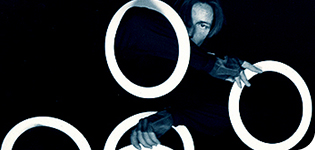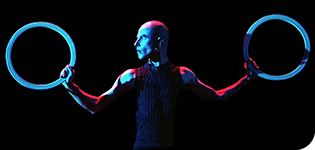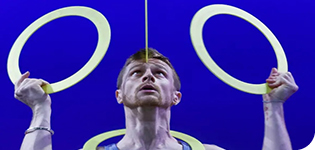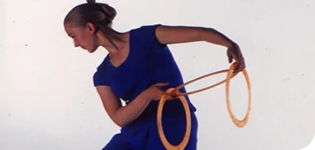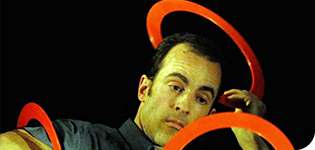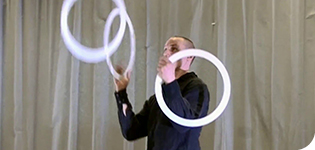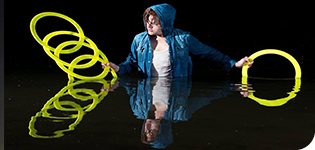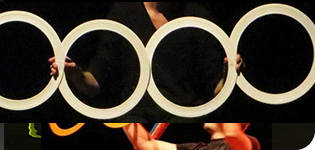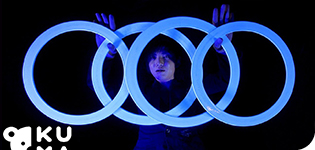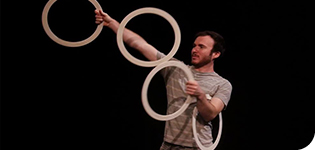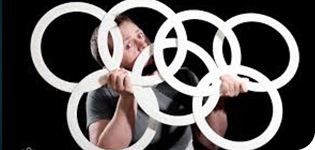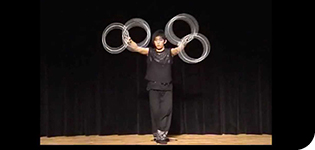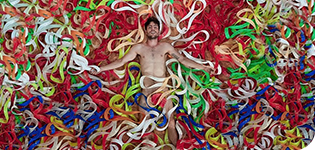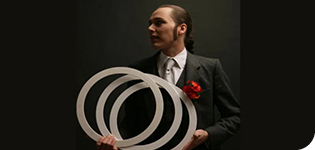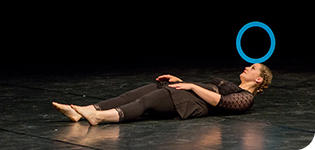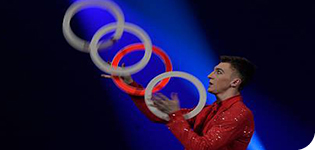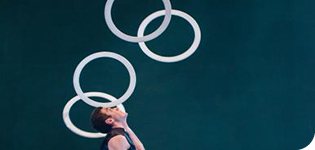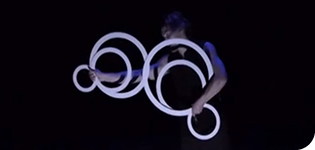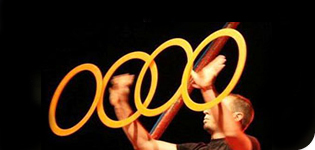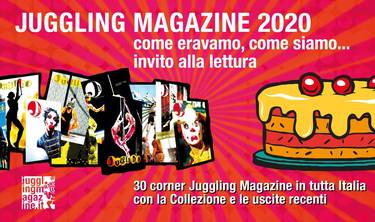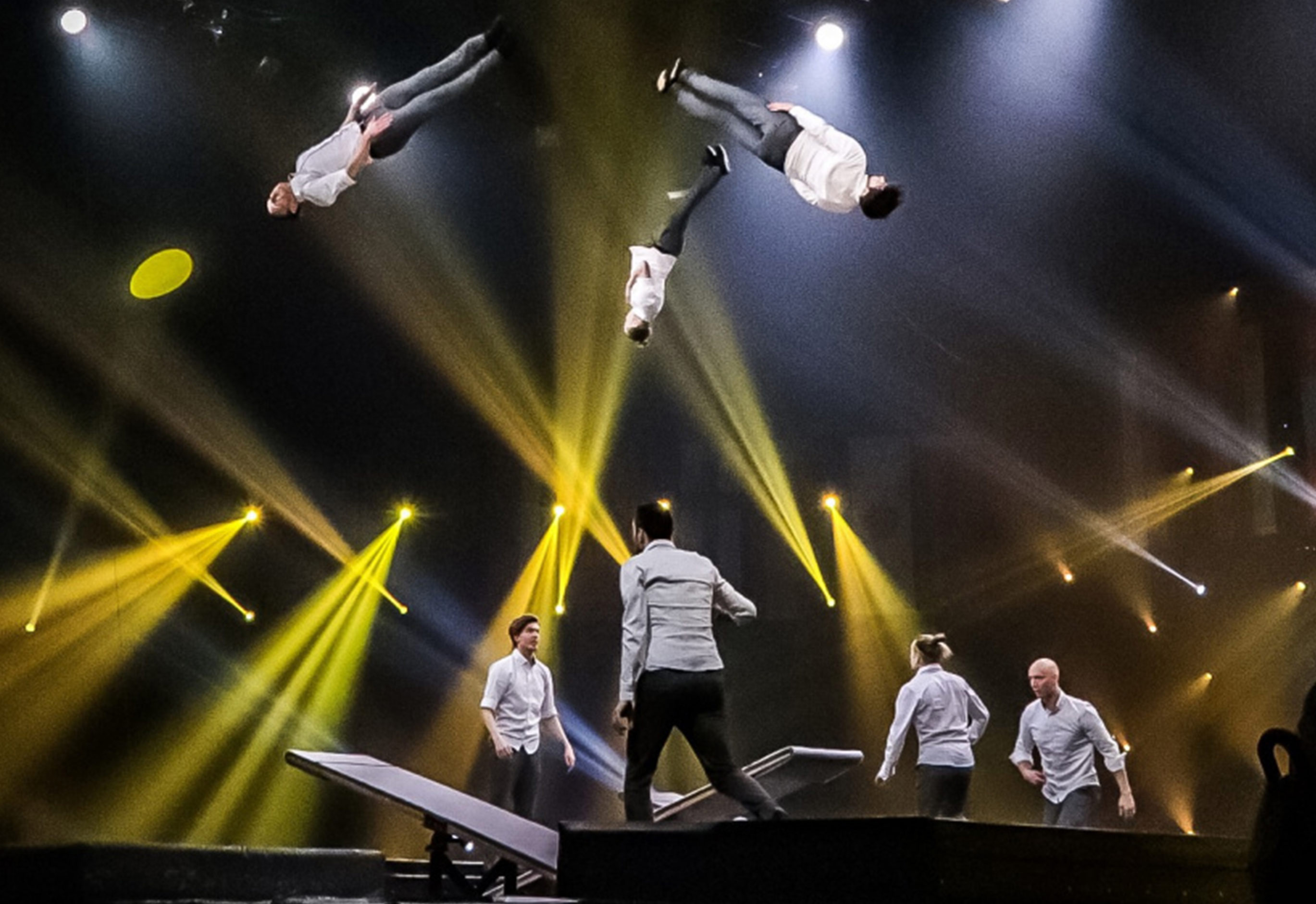
ANELLI
a cura di "Riky" Riccardo Tanca
La globalizzazione dell’informazione ha dato una spinta al progresso in tutti i campi della società e il mondo della giocoleria non ne è stato esente. Alla fine del XX secolo, su una videocassetta o all’interno di un varietà televisivo, un giocoliere poteva ammirare un suo omologo dall’altra parte del pianeta e rimanerne inevitabilmente influenzato. Sono aumentati così, particolarmente nel mondo occidentale, i giocolieri amatoriali e in tanti si destreggiano con gli anelli. Da ultimo, abbiamo assistito alla nascita di nuove forme di spettacolo contemporaneo, alcune diventate presto famose in tutto il globo, come il Cirque du Soleil, fondato nel 1984, punta d’iceberg di un movimento dagli esiti vari e inattesi.
I giocolieri che decidevano di portare sul palco un numero di anelli erano soliti offrire al pubblico una performance classica, con tanti toss, figli di artisti dell’epoca precedente come Sergei Ignatov, Anthony Gatto e Albert Lucas, alla ricerca spasmodica del numero massimo di anelli lanciati in aria. Se negli ultimi vent’anni, tanti e importanti giocolieri hanno fatto progredire la tecnica del toss juggling, come per esempio Delaney Bayles o Pavel Evsukevich, erano ancora pochi quelli che all’inizio del XXI secolo si erano distinti per una manipolazione degli anelli in maniera differente. Tra questi emergono Jay Gilligan, Jeremy James, Jochen Schell, Vladimir Zarkov.
Con l’aumento della partecipazione ai raduni di giocoleria e festival, ma soprattutto grazie all’avvento di internet e quindi dei social network, l’evoluzione della manipolazione con gli anelli prende una rincorsa che ancora oggi non si è fermata. Una forte spinta all’originalità nei primi anni 2000 è arrivata grazie al trio Ville Valo, Maksim Komaro, Jay Gilligan, che ha pubblicato videocassette di manipolazioni, anche legate all’anello, rivoluzionarie per l’epoca e a giocolieri come Sean Blue, Kati Ylä-Hokkala, Denis Paumier che hanno messo solide basi per una futura evoluzione.
Del 2005 viene pubblicato un altro video importantissimo per l’evoluzione e diffusione della manipolazione della giocoleria e degli anelli, “9-1 nordic object”, direttamente dalla Scandinavia, che ci fa conoscere Isak Lindberg, Samuel Gustavsson, Viktor Gyllenberg e sulla scia negli anni successivi Petter Wadsten, Arttu Lahtinen, Emil Dahl. Si tratta di nuovi performer che decidono di evitare il lancio in aria degli anelli, sperimentare nuove manipolazioni e ricercare un contatto con il corpo.
Non va dimenticato il movimento multiculturale legato al contact juggling capeggiato da Ryan Mellors e del gruppo dei “Ministry of Manipulation”, di cui sopravvive ancora un blog. Appassionante il tentativo (riuscito) di creare un movimento di giocolieri contemporanei in Ucraina, “Raw Art”, di cui ricordiamo uno dei fondatori e ottimo giocoliere con gli anelli che è Taras Podzniakov.
Con la nascita di YouTube aumenta la sfida non competitiva alla ricerca di originalità nel movimento, a vantaggio e alla portata di tutti i giocolieri più fantasiosi, professionisti e appassionati. Fondamentali per una divulgazione e crescita del movimento sono stati Wes Peden, Patrik Elmnert e Tony Pezzo che hanno saputo unire alla manipolazione toss entusiasmanti. Nasce invece ad oriente uno stile giapponese: da Komei Aoki, Teruki Okamoto, Takaaki Matsumura, dallo stile contemporaneo e pop, a Ouka che porta in auge una manipolazione denominata 8rings.
Non posso non citare, infine, ottimi manipolatori che, più che inventare, hanno trasformato, innovato e creato variazioni come Emmanuël Boissé Pinard, Norbi Whitney, Akira Miyano, Tomohiro Kobayashi, Gon Fernandez, David Severins, Filip Zahradnický, Guy Waerenburgh, Kathrin Wagner, Alexander Kulakov, Kyle Driggs, Juan Marmol, Jean-Baptiste Diot, Zac Mcallister, Jean-Philippe Deltell, Olli Vuorinen, Andrés Torres Diaz, o i nostrani Kiko Porcella, Alessandro Budroni e anche io un po’.
RINGS
by "Riky" Riccardo Tanca
The evolution of ring juggling/manipulation 2000-2020
The globalisation of information has boosted progress in all areas of our society and the world of juggling has not been excluded. At the end of the 20th century, in a videotape or in a television variety show, a juggler could admire his counterpart on the other side of the planet and be inevitably influenced by him. Amateur jugglers are on the rise, particularly in the Western world, and many of them practice ring juggling/manipulation.
Finally, we have witnessed the birth of new forms of contemporary entertainment, one of which was the Cirque du Soleil experience in 1984. The juggler who decides to bring a number of rings onto the stage is used to offer the public classic performances, with many toss, sons of previous artists such as Sergei Ignatov and Anthony Gatto, and the spasmodic search for the maximum number of rings thrown into the air.
While many prominent jugglers have advanced the technique of toss juggling over the past twenty years, such as Delaney Bayles or Pavel Evsukevich, there are few who have distinguished themselves and manipulated the rings in a different way at the beginning of the 21st century. These include Jay Gilligan, Jeremy James, Jochen Schell and Vladimir Zarkov.
With the increase in participation in juggling exhibitions and festivals, but above all thanks to the advent of the internet and therefore of social networks, the evolution of ring manipulation took on a run-up that has not yet stopped.
A strong push for originality in the early 2000s came from the trio Ville Valo, Maksim Komaro, Jay Gilligan, who published videotapes of manipulations, also linked to the ring, which were revolutionary at the time, and from jugglers such as Sean Blue, Kati Ylä-Hokkala, Denis Paumier who laid solid foundations for a future evolution.
Another very important video for the evolution and diffusion of juggling and ring manipulation was published in 2005: "9-1 nordic object", directly from Scandinavia, which introduced us to Isak Lindberg, Samuel Gustavsson, Viktor Gyllenberg and, in the following years, Petter Wadsten, Arttu Lahtinen, Emil Dahl.
These were new performers who decided to avoid throwing rings in the air, experimenting with new manipulations and seeking contact with the body.
We should not forget the multicultural movement linked to contact juggling led by Ryan Mellors and the 'Ministry of Manipulation' group, whose blog still survives.
It is also exciting the (successful) attempt to create a movement of contemporary jugglers from the Ukraine, 'Raw Art', of which Taras Podzniakov is one of the founders and an excellent ring juggler.
With the birth of YouTube, the non-competitive challenge in the search for originality has increased to the benefit and within the reach of all imaginative, professional and passionate jugglers.
Wes Peden, Patrik Elmnert and Tony Pezzo were fundamental to the spread and growth of the movement, combining manipulation with exciting juggling.
Finally, a Japanese style was born: from Komei Aoki, Teruki Okamoto, Takaaki Matsumura, with a contemporary and pop style, to Ouka who brought a manipulation called 8rings into vogue.
Lastly, I cannot fail to mention excellent manipulators who, rather than inventing, have transformed, innovated and created variations such as Emmanuël Boissé Pinard, Norbi Whitney, Akira Miyano, Tomohiro Kobayashi, Gon Fernandez and David Severins, Filip Zahradnický, Guy Waerenburgh, Kathrin Wagner, Alexander Kulakov, Kyle Driggs, Juan Marmol, Jean-Baptiste Diot, Zac Mcallister, Jean-Philippe Deltell, Olli Vuorinen or our own Kiko Porcella and Alessandro Budroni, and me too a little.

